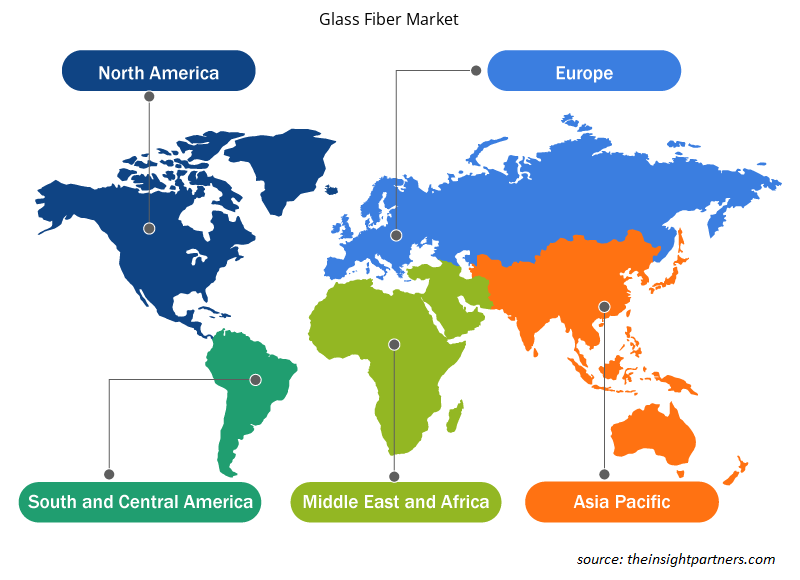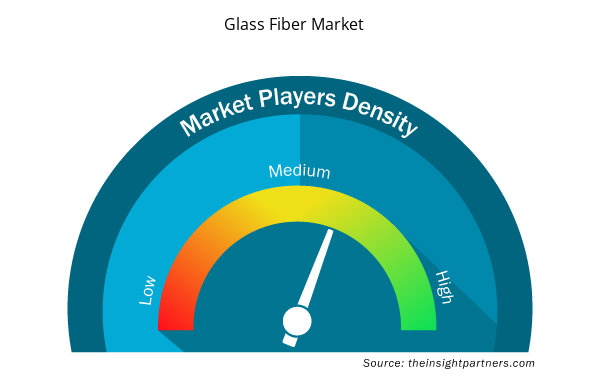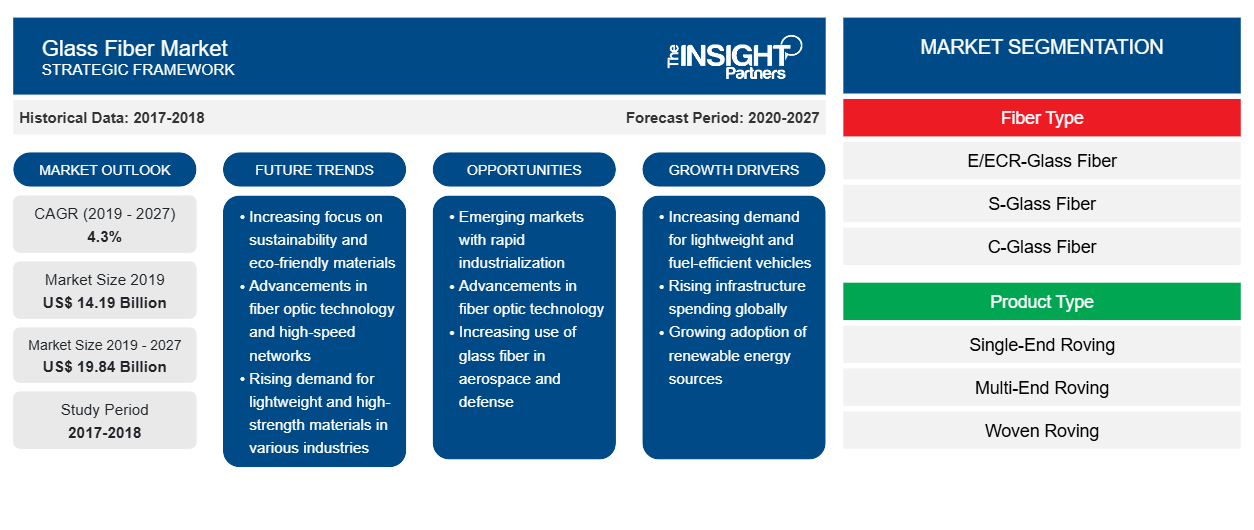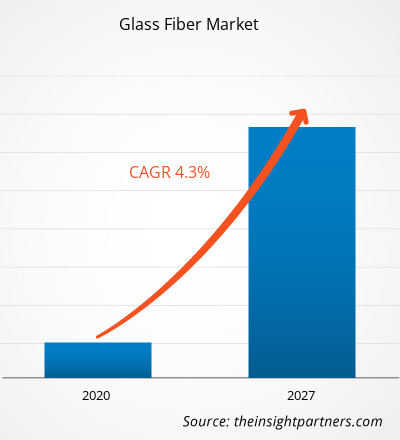2019 年玻璃纤维市场价值为 141.9355 亿美元,预计到 2027 年将达到 198.3762 亿美元,2020 年至 2027 年的复合年增长率为 4.3%。
玻璃纤维是一种由极细的玻璃丝组成的材料,这些玻璃丝被组合成纱线并编织成织物。它是通过在三级炉中混合和熔化二氧化硅(SiO2)、石灰石和纯碱,将熔融的玻璃挤出通过炉底的套管,然后用水冷却细丝而制成的。玻璃纤维具有出色的耐腐蚀性、更高的刚度和强度、高抗拉强度以及耐高温性和耐用性。这些纤维在汽车、建筑、船舶、风能、航空航天和国防等终端行业中得到应用。然而,生产过程的挑战、新技术的成本密集性以及玻璃纤维的低利润率限制了市场的增长。
2019 年,亚太地区在全球玻璃纤维市场中贡献了最大的份额。预计亚太地区将成为未来几年增长最快的玻璃纤维市场。随着交通运输、建筑、电气电子、航空航天等行业的增长,该地区对玻璃纤维的需求大幅上升。建筑业是玻璃纤维的主要消费者之一。印度和中国等新兴市场的快速基础设施建设推动了对先进玻璃纤维的需求。例如,印度政府为改善住宅和交通基础设施做出了巨大努力。根据工业和国内贸易促进部 (DPIIT) 的数据,2000 年 4 月至 2020 年 9 月期间,建筑开发领域和基础设施活动的外国直接投资 (FDI) 分别为 257.8 亿美元和 172.2 亿美元。对基础设施建设的持续投资将极大地促进玻璃纤维的消费。此外,玻璃纤维还用于船舶、机翼能源和消费品行业,这些行业也受到政府的大量投资,从而支持了该地区玻璃纤维市场的增长。
COVID-19 于 2019 年 12 月首先在中国武汉爆发,此后迅速蔓延至全球。截至 2021 年 3 月,美国、印度、巴西、俄罗斯、法国、英国、土耳其、意大利和西班牙是确诊病例和报告死亡人数最多的国家。由于封锁、旅行禁令和企业停业,COVID-19 疫情已影响到各国的经济和行业。此外,欧洲、亚洲和北美国家实施的全球旅行禁令也影响了商业合作和伙伴关系机会。所有这些因素预计都会对化学品和材料行业产生负面影响,从而成为玻璃纤维市场增长的制约因素。
定制此报告以满足您的需求
您可以免费定制任何报告,包括本报告的部分内容、国家级分析、Excel 数据包,以及为初创企业和大学提供优惠和折扣
- 获取此报告的关键市场趋势。这个免费样品将包括数据分析,从市场趋势到估计和预测。
市场洞察
建筑行业对玻璃纤维的需求不断增长
玻璃纤维在建筑行业中用作绝缘、表面涂层、包层和屋顶原材料。它们价格低廉,具有与其他纤维(包括聚合物和碳纤维)大致相同的机械性能,例如刚度、柔韧性、透明度、抗化学爆发性和惰性。玻璃纤维用于玻璃纤维增强混凝土,用于建造墙壁、壁炉周围、地基、包层、梳妆台面和混凝土台面。它主要用于建筑外墙板和建筑预制混凝土。玻璃纤维作为主要载体,提供高抗拉强度,使混凝土具有柔韧性和抗开裂性。耐碱玻璃纤维(ARGF)广泛应用于建筑材料中。ARGF 显著提高了混凝土的抗拉强度、弯曲韧性、断裂模量和耐磨性。这种混凝土用于防止裂缝,因此在建筑领域得到广泛应用。
全球建筑业的快速发展预计将增加对玻璃纤维的需求。美国等发达国家新建住宅建筑支撑了对玻璃纤维的需求。例如,根据美国人口普查局的数据,2020 年 3 月,美国经建筑许可批准的住宅总套数年率为 1,353,000 套,比 2019 年 3 月增长 5%。除此之外,中国和印度等新兴市场的强劲经济增长正在推动基础设施建设的强劲发展。这些国家正在经历新建筑建设的增加;现有结构的维护和维修、改造或翻新;预切的现场组装;临时建筑的建设;以及电梯和自动扶梯等专用建筑设施的安装。所有这些因素预计将在建筑行业产生对玻璃纤维的持续需求。
光纤类型洞察
根据纤维类型,全球玻璃纤维市场细分为 E/ECR 玻璃纤维、S 玻璃纤维、C 玻璃纤维和其他。E/ECR 玻璃纤维部门在 2019 年占据玻璃纤维市场的最高市场份额。E 玻璃是一种电子玻璃,是主要的玻璃纤维类型之一,具有强度高、绝缘性好、防水和耐腐蚀等特性。E 玻璃纤维是所有纤维增强材料和纤维增强复合材料中应用最广泛的,因为它们成本合理、弹性模量低,并且比其他玻璃纤维开发得早。另一方面,ECR 玻璃与 E 玻璃类似,但不含氟和硼。ECR 玻璃纤维环保,具有优异的耐酸性、耐水性、耐高温性和耐碱性。此外,ECR 玻璃纤维具有出色的介电强度、较低的漏电和更大的表面电阻。 ECR 玻璃纤维自 2005 年 1 月起按照 ASTM-D578-1999 标准制造,适用于除透明 FRP(纤维增强塑料)面板应用之外的所有电子玻璃应用。E/ECR 玻璃纤维在汽车、电子产品和电子设备中的广泛使用预计将在预测期内推动该领域的增长。
产品类型洞察
根据产品类型,全球玻璃纤维市场细分为单端粗纱、多端粗纱、编织粗纱和其他。其他部分在 2019 年引领了全球玻璃纤维市场。其他部分包括织物、CSM、CFM、DUCS、CS、OptiSpray 粗纱、Cem-FILRoving、Direct 粗纱和其他。OptiSpray 粗纱为制造商提供了一种引人注目的解决方案,他们希望节省时间和树脂,同时提高产品性能。Cem-FIL 粗纱是一种耐碱玻璃纤维组装粗纱,用于通过同时喷涂法制造玻璃纤维增强混凝土复合材料。Cem-FILRoving 具有耐碱玻璃、良好的解卷性、易于切碎和高分裂效率等优点,非常适合用于复杂型材和出色的机械性能。欧文斯康宁 (Owens Corning) 等制造商提供 OptiSpray F 粗纱、Cem-FILRoving 5325、Cem-FILRoving 62.4 和 Cem-FIL 粗纱 62/70。圣戈班 Vetrotex 提供 Direct 粗纱,这是一种由 E-Glass 制成的无接头单端粗纱,适用于多种纺织技术。
应用程序洞察
根据应用,全球玻璃纤维市场细分为海洋、运输、航空航天、建筑、电气和电子、消费品等
2019 年,运输部门引领了全球玻璃纤维市场。玻璃纤维用于运输行业,例如车顶板、门窗、冷却通风机、行李箱、座椅和头枕背板。玻璃纤维具有更高的强度重量比,这是制造汽车的重要因素。预计这些因素将在预测期内推动运输行业玻璃纤维市场的增长。
制造过程洞察
根据制造工艺,全球玻璃纤维市场细分为手糊、喷射、预浸料铺层、注塑、压缩成型、树脂灌注和其他。其他部分在 2019 年引领了全球玻璃纤维市场。其他部分包括拉挤、离心铸造、混合注塑/热成型等。拉挤是一种低成本、简单、连续的工艺,几十年来一直用于玻璃纤维和聚酯树脂。不过,近年来,该工艺也在先进的复合材料应用中得到应用。拉挤可生产出光滑的成品零件,通常不需要后处理。在离心铸造法中,环氧树脂或乙烯基酯树脂被灌注到 150G 离心纺丝模具中,渗透到包裹在模具内表面的编织织物中。
Johns Manville;巨石股份有限公司;重庆国际复合材料股份有限公司 (CPIC);果阿玻璃纤维有限公司;日本电气硝子有限公司;圣戈班 Vetrotex;四川威博新材料集团有限公司;泰山玻璃纤维股份有限公司;台湾玻璃集团和欧文斯科宁是玻璃纤维市场的主要市场参与者。这些公司在全球范围内提供产品,从而帮助它们满足更广泛的客户群。这些市场的主要参与者高度专注于开发高质量和创新的产品以满足客户的要求。在过去几年中,市场上运营的公司已经意识到玻璃纤维市场的巨大潜力,并高度参与并购和产品发布等战略。例如,在 2020 年,巨石推出了 E9 超高模量玻璃纤维,以促进轻型风力涡轮机叶片的发展。
玻璃纤维市场区域洞察
Insight Partners 的分析师已详尽解释了预测期内影响玻璃纤维市场的区域趋势和因素。本节还讨论了北美、欧洲、亚太地区、中东和非洲以及南美和中美洲的玻璃纤维市场细分和地理位置。

- 获取玻璃纤维市场的区域具体数据
玻璃纤维市场报告范围
| 报告属性 | 细节 |
|---|---|
| 2019 年市场规模 | 141.9亿美元 |
| 2027 年市场规模 | 198.4亿美元 |
| 全球复合年增长率(2019 - 2027) | 4.3% |
| 史料 | 2017-2018 |
| 预测期 | 2020-2027 |
| 涵盖的领域 | 按纤维类型
|
| 覆盖地区和国家 | 北美
|
| 市场领导者和主要公司简介 |
|
玻璃纤维市场参与者密度:了解其对业务动态的影响
玻璃纤维市场正在快速增长,这得益于最终用户需求的不断增长,而这些需求又源于消费者偏好的不断变化、技术进步以及对产品优势的认识不断提高等因素。随着需求的增加,企业正在扩大其产品范围,进行创新以满足消费者的需求,并利用新兴趋势,从而进一步推动市场增长。
市场参与者密度是指在特定市场或行业内运营的企业或公司的分布情况。它表明在给定市场空间中,相对于其规模或总市场价值,有多少竞争对手(市场参与者)存在。
在玻璃纤维市场运营的主要公司有:
- 约翰斯·曼维尔
- 巨石股份有限公司
- 重庆国际复合材料有限公司 (CPIC)
- 果阿玻璃纤维有限公司
- 日本电气硝子株式会社
免责声明:上面列出的公司没有按照任何特定顺序排列。

- 了解玻璃纤维市场顶级关键参与者概况
报告亮点
- 全球玻璃纤维市场的渐进式行业趋势,帮助参与者制定有效的长期战略
- 发达市场和发展中市场采用的业务增长战略
- 2017年至2027年全球玻璃纤维市场定量分析
- 各行业对玻璃纤维的需求估计
- PEST 分析可说明行业内买家和供应商预测市场增长的有效性
- 了解竞争激烈的市场形势和玻璃纤维需求的最新发展
- 市场趋势和前景以及推动和抑制玻璃纤维市场增长的因素
- 通过了解支撑全球玻璃纤维市场增长的商业利益的战略来做出决策
- 各市场节点的玻璃纤维市场规模
- 全球玻璃纤维市场的详细概述和细分以及行业动态
- 各地区玻璃纤维市场规模及增长机遇
全球玻璃纤维市场,按纤维类型划分
- E/ECR-玻璃纤维
- S-玻璃纤维
- C-玻璃纤维
- 其他的
全球玻璃纤维市场,按产品类型划分
- 单头粗纱
- 多头粗纱
- 编织粗纱
- 其他的
全球玻璃纤维市场(按应用划分)
- 海洋
- 运输
- 航天
- 建造
- 电气和电子
- 消费品
- 其他的
全球玻璃纤维市场,按制造工艺划分
- 手工铺层
- 喷洒
- 预浸料铺层
- 注塑成型
- 压缩成型
- 树脂灌注
- 其他的
公司简介
- 重庆国际复合材料有限公司 (CPIC)
- 约翰斯·曼维尔
- 中国巨石有限公司
- 日本电气硝子株式会社
- 欧文斯科宁
- 圣戈班公司
- 四川韦博新材料集团有限公司
- 泰山玻璃纤维股份有限公司(CTG)
- 台湾玻璃集团
- 果阿玻璃纤维有限公司
- 历史分析(2 年)、基准年、预测(7 年)及复合年增长率
- PEST 和 SWOT 分析
- 市场规模价值/数量 - 全球、区域、国家
- 行业和竞争格局
- Excel 数据集



Report Coverage
Revenue forecast, Company Analysis, Industry landscape, Growth factors, and Trends

Segment Covered
This text is related
to segments covered.

Regional Scope
North America, Europe, Asia Pacific, Middle East & Africa, South & Central America

Country Scope
This text is related
to country scope.
常见问题
In 2019, The E/ECR-glass fiber segment accounted for a larger share of the global glass fiber market. E-glass is among the leading types of glass fibers with properties such as high-strength, good insulation, water-resistance, and corrosion resistance. It is extensively used in aerospace, marine, and industrial applications. Apart from this, E-glass finds vast applications in automotive & transport, construction, wind energy and pipes & tanks due to its beneficial characteristics and low-cost. ECR-glass fiber also called electronic glass fiber has a high mechanical strength, good waterproofing ratio and electrical acidic and alkali corrosion resistance as compared to E-glass fiber. It is used in transparent GRP panel applications. Growing demand from various end-use industries has spurred the growth of this segment during the forecast period.
The key players providing glass fibers are Johns Manville; Jushi Co., Ltd.; Chongqing Polycomp International Corp. (CPIC); Goa Glass Fiber Ltd; Nippon Electric Glass Co. Ltd; Saint-Gobain Vetrotex; Sichuan Weibo New Material Group Co., Ltd.; Taishan Fiberglass Inc; Taiwan Glass Group; and Owens Corning among others
In 2019 , the pressure vessel composite materials market was dominated by Asia Pacific. With the growth of transportation, construction, electrical & electronics, aerospace, and other industries, the demand for glass fiber has substantially gone up in the region. Construction industry is among the major consumers of glass fibers. Rapid infrastructural development in emerging markets such as India and China is driving the demand for advanced glass fibers. In addition, Glass fibers are also used in marine, wing energy and consumer goods industry, these industries are also experiencing high investment from government and thus supporting the growth of glass fibers market in region.
Trends and growth analysis reports related to Chemicals and Materials : READ MORE..
The List of Companies - Global Glass Fibers Market
- Johns Manville
- Jushi Co., Ltd.
- Chongqing Polycomp International Corp. (CPIC)
- Goa Glass Fiber Ltd
- Nippon Electric Glass Co. Ltd
- Saint-Gobain Vetrotex
- Sichuan Weibo New Material Group Co., Ltd.
- Taishan Fiberglass Inc
- Taiwan Glass Group
- Owens Corning
The Insight Partners performs research in 4 major stages: Data Collection & Secondary Research, Primary Research, Data Analysis and Data Triangulation & Final Review.
- Data Collection and Secondary Research:
As a market research and consulting firm operating from a decade, we have published and advised several client across the globe. First step for any study will start with an assessment of currently available data and insights from existing reports. Further, historical and current market information is collected from Investor Presentations, Annual Reports, SEC Filings, etc., and other information related to company’s performance and market positioning are gathered from Paid Databases (Factiva, Hoovers, and Reuters) and various other publications available in public domain.
Several associations trade associates, technical forums, institutes, societies and organization are accessed to gain technical as well as market related insights through their publications such as research papers, blogs and press releases related to the studies are referred to get cues about the market. Further, white papers, journals, magazines, and other news articles published in last 3 years are scrutinized and analyzed to understand the current market trends.
- Primary Research:
The primarily interview analysis comprise of data obtained from industry participants interview and answers to survey questions gathered by in-house primary team.
For primary research, interviews are conducted with industry experts/CEOs/Marketing Managers/VPs/Subject Matter Experts from both demand and supply side to get a 360-degree view of the market. The primary team conducts several interviews based on the complexity of the markets to understand the various market trends and dynamics which makes research more credible and precise.
A typical research interview fulfils the following functions:
- Provides first-hand information on the market size, market trends, growth trends, competitive landscape, and outlook
- Validates and strengthens in-house secondary research findings
- Develops the analysis team’s expertise and market understanding
Primary research involves email interactions and telephone interviews for each market, category, segment, and sub-segment across geographies. The participants who typically take part in such a process include, but are not limited to:
- Industry participants: VPs, business development managers, market intelligence managers and national sales managers
- Outside experts: Valuation experts, research analysts and key opinion leaders specializing in the electronics and semiconductor industry.
Below is the breakup of our primary respondents by company, designation, and region:

Once we receive the confirmation from primary research sources or primary respondents, we finalize the base year market estimation and forecast the data as per the macroeconomic and microeconomic factors assessed during data collection.
- Data Analysis:
Once data is validated through both secondary as well as primary respondents, we finalize the market estimations by hypothesis formulation and factor analysis at regional and country level.
- Macro-Economic Factor Analysis:
We analyse macroeconomic indicators such the gross domestic product (GDP), increase in the demand for goods and services across industries, technological advancement, regional economic growth, governmental policies, the influence of COVID-19, PEST analysis, and other aspects. This analysis aids in setting benchmarks for various nations/regions and approximating market splits. Additionally, the general trend of the aforementioned components aid in determining the market's development possibilities.
- Country Level Data:
Various factors that are especially aligned to the country are taken into account to determine the market size for a certain area and country, including the presence of vendors, such as headquarters and offices, the country's GDP, demand patterns, and industry growth. To comprehend the market dynamics for the nation, a number of growth variables, inhibitors, application areas, and current market trends are researched. The aforementioned elements aid in determining the country's overall market's growth potential.
- Company Profile:
The “Table of Contents” is formulated by listing and analyzing more than 25 - 30 companies operating in the market ecosystem across geographies. However, we profile only 10 companies as a standard practice in our syndicate reports. These 10 companies comprise leading, emerging, and regional players. Nonetheless, our analysis is not restricted to the 10 listed companies, we also analyze other companies present in the market to develop a holistic view and understand the prevailing trends. The “Company Profiles” section in the report covers key facts, business description, products & services, financial information, SWOT analysis, and key developments. The financial information presented is extracted from the annual reports and official documents of the publicly listed companies. Upon collecting the information for the sections of respective companies, we verify them via various primary sources and then compile the data in respective company profiles. The company level information helps us in deriving the base number as well as in forecasting the market size.
- Developing Base Number:
Aggregation of sales statistics (2020-2022) and macro-economic factor, and other secondary and primary research insights are utilized to arrive at base number and related market shares for 2022. The data gaps are identified in this step and relevant market data is analyzed, collected from paid primary interviews or databases. On finalizing the base year market size, forecasts are developed on the basis of macro-economic, industry and market growth factors and company level analysis.
- Data Triangulation and Final Review:
The market findings and base year market size calculations are validated from supply as well as demand side. Demand side validations are based on macro-economic factor analysis and benchmarks for respective regions and countries. In case of supply side validations, revenues of major companies are estimated (in case not available) based on industry benchmark, approximate number of employees, product portfolio, and primary interviews revenues are gathered. Further revenue from target product/service segment is assessed to avoid overshooting of market statistics. In case of heavy deviations between supply and demand side values, all thes steps are repeated to achieve synchronization.
We follow an iterative model, wherein we share our research findings with Subject Matter Experts (SME’s) and Key Opinion Leaders (KOLs) until consensus view of the market is not formulated – this model negates any drastic deviation in the opinions of experts. Only validated and universally acceptable research findings are quoted in our reports.
We have important check points that we use to validate our research findings – which we call – data triangulation, where we validate the information, we generate from secondary sources with primary interviews and then we re-validate with our internal data bases and Subject matter experts. This comprehensive model enables us to deliver high quality, reliable data in shortest possible time.


 获取此报告的免费样本
获取此报告的免费样本